The Risks from Heavy Fuel Oil in the Arctic
![]()

Threat to Arctic
Heavy fuel oil (HFO) is an extremely viscous marine fuel that breaks down slowly in the marine environment, particularly in colder regions like the Arctic.

Unmanageable spill
In the event of a heavy fuel oil spill, lack of infrastructure, uncharted waters, severe weather conditions and navigational hazards such as sea ice, make spill response efforts nearly impossible.

Risk to indigenous residents
HFO spills pose a severe risk to many indigenous residents of the Arctic region that depend on marine resources for their nutritional, cultural, and economic needs.

Harmful pollutants
HFO produces higher emissions of harmful pollutants like sulphur oxide, nitrogen oxides, and black carbon, all of which have been linked to an increased risk of heart and lung disease and premature death. Switching from HFO to low-sulphur distillate fuel would reduce black carbon emissions by 30%-80%.

Accelerated warming
Black carbon has a potent climate warming effect when emitted at high latitudes. The warming impact is increased by at least a factor of 3 in the Arctic region as compared to emissions over the open ocean. This is because in the atmosphere, the black carbon particles absorb incoming radiation from above, as well as reflected radiation from below – doubling the warming impact.

Self-reinforcing warming cycle
When black carbon particles fall onto the Arctic snow and ice, radiation scattered from the snow and ice hits the deposited black carbon particles and causes further warming, plus the amount of sunlight reflected back into space is reduced. Snow and ice melt is accelerated increasing the surface area of exposed, dark ocean water, and promoting a self-reinforcing cycle of human-induced climate warming.
What is HFO?
Already banned for since 2011 in Antarctica and in all the waters around the Arctic archipelago of Svalbard from January 2022, heavy fuel oil is a viscous and polluting fossil fuel that powers ships throughout our seas and oceans – accounting for 80% of marine fuel used worldwide. Around 75% of marine fuel currently carried in the Arctic is heavy fuel oil (HFO).
If HFO is spilled in cold polar waters, it is likely to break down very slowly, and prove almost impossible to clean up. A HFO spill would have long-term devastating effects on Arctic indigenous communities, livelihoods and the marine ecosystems they depend upon. As sea ice melts and opens up Arctic waters further, even larger non-Arctic state-flagged vessels running on HFO are likely to divert to Arctic waters in search of shorter journey times, greatly increasing the risks of HFO spills.
Burning HFO produces black carbon particles which are emitted in the exhaust fumes. When they fall on snow, on glacier ice and sea ice, the reflectivity (albedo) is reduced and the absorption of heat increases. More Arctic shipping using HFO will lead to increased black carbon emissions, fueling an already accelerating feedback loop.
Marine fuels are classified by their viscosity. Pictured are a low-sulfur distillate (left, low viscosity) and a high-sulfur residual fuel oil (right, high viscosity).
Credit: Asia Weekly
The International Maritime Organization’s HFO Ban
The Clean Arctic Alliance was formed in 2016 to persuade the International Maritime Organization (IMO) to bring about a ban on the use and carriage of heavy fuel oil (HFO) by Arctic shipping.
The Clean Arctic Alliance called for a strong, timely ban that would protect the Arctic marine environment, as well as the communities who depend on it, from the risk of a disastrous heavy fuel oil spill, while using fuels cleaner than HFO will help to reduce black carbon emissions in the region.
Following five years of advocacy and pressure as part of the “HFO Free Arctic” campaign, over a decade after the Arctic Council first concluded that oil spills are the greatest risk posed by shipping, in June 2021 the International Maritime Organization finally adopted a ban on the use and carriage of heavy fuel oil in the Arctic.
However, the ban adopted by the IMO’s Marine Environment Protection Committee is far weaker than was required, leaving the Arctic, its Indigenous communities and its wildlife facing the risk of a HFO spill for another decade.
The IMO ban allows ships in the Arctic to carry and burn significant quantities of HFO in the coming years, resulting in ongoing HFO spill risks, continued high emissions of black carbon, and failure to achieve protection of a region that is rapidly changing due to climate warming.
The IMO’s HFO ban will come into force in mid 2024, but only gradually, and will initially only address a small proportion of heavy fuel oil currently being used in the Arctic. It allows for exemptions for ships with protected fuel tanks, and a controversial clause allowing countries which have a coastline bordering Arctic waters to issue waivers for ships flying their flag to keep using HFO. Arctic shipping continues to grow. Recent Arctic Council studies of ship activity in the Arctic have shown an increase of 25 percent between 2013 and 2019 and a 75 percent increase in total distance travelled over the same time period. Many of these vessels, along with new vessels, as Arctic shipping continues to grow, will be able to make use of these exemptions and waivers, resulting in an overall growth of the amount of HFO being used and carried. This means that the ban will only take truly full effect from July 1, 2029.
HFO and Black Carbon
The Arctic doesn’t have the luxury of waiting until 2029 for action to protect. Arctic shipping and the global climate crisis is having a profound impact on the Arctic now. When ships burn HFO, they produce black carbon particles, which are emitted into the environment via their exhaust fumes. These short-lived climate forcers contribute to the warming of the Earth’s atmosphere and when they fall on snow, or on glacier ice and sea ice, they reduce the reflectivity, or albedo, of that surface — and consequently increase how much heat it absorbs. Black carbon emissions from shipping have already increased by 85 percent between 2015 and 2019, and more Arctic shipping using HFO will lead to increased black carbon emissions, further fuelling an already accelerating feedback loop. It has been estimated that the IMO’s HFO ban will only reduce the volume of black carbon emissions by a mere 5 percent.
By switching vessels operating in the Arctic to readily available cleaner fuels, or to alternative forms of propulsion, black carbon emissions can be quickly reduced. Use of diesel fuel along with the installation of particulate filters or precipitators, as prescribed for other forms of transport, can reduce emissions of black carbon by more than 90 percent.
The Solution
The Clean Arctic Alliance is calling on Arctic governments to require ships in the Arctic to reduce black carbon emissions by switching to distillate or other cleaner fuels or forms of propulsion when operating in or near the Arctic, and to strengthen and speed up the implementation of an international ban on the use and carriage of heavy fuel oil as fuel in the Arctic.
Arctic governments can also show leadership at home, by going beyond the unambitious IMO ban, by banning HFO use and carriage in their own Arctic waters and requiring the use of cleaner fuels by nationally-flagged vessels. Norway is already leading the way, by extending an existing partial ban on HFO in the waters surrounding Svalbard. The new ban will take effect from January 2021 and will stop all HFO use and carriage in the area.
If progress is to be made in dealing with the impact of shipping in the Arctic and protecting the remaining Arctic summer sea ice, ministers from Iceland, the U.S., Canada, Russia, Sweden, Finland, and the Kingdom of Denmark, must follow Norway’s example, and move faster and much more effectively than the IMO, by getting heavy fuel oil out of the Arctic now.
HFO Ban 2024

Arctic Heavy Fuel Oil Ban Arctic States Must Drop Climate-Warming Loopholes
As an International Maritime Organization (IMO) ban on the use and carriage heavy fuel oil (HFO) by Arctic shipping comes into force today, the Clean Arctic Alliance calls on IMO member states, particularly Arctic coastal countries, to implement the Arctic HFO ban and enforce it fully with immediate effect – without resorting to loopholes.

Arctic Heavy Fuel Oil Ban Media Coverage, June/July 2024
Collection of news coverage of the July 1st 2024 Arctic heavy fuel oil ban, featuring the Clean Arctic Alliance.

Everything You Need to Know About the Arctic Heavy Fuel Oil Ban
On July 1st 2024, an International Maritime Organization (IMO) ban on the use and carriage of heavy fuel oil (HFO) by Arctic shipping will come into force. This web page brings together recent briefings, webinars, infographics, press releases and other articles regarding the ban, its strengths and weaknesses, and how it provides opportunities for Arctic countries and the shipping industry to ensure heavy fuel oil is no longer a part of Arctic shipping.

Why the Shipping Industry Must Seize Opportunity Posed by Arctic Heavy Fuel Oil Ban
On July 1st, an International Maritime Organization (IMO) ban on the use and carriage of heavy fuel oil (HFO) by Arctic shipping will come into force. At first glance, this looks like great news indeed for the Arctic environment, and the people and wildlife who depend upon it.
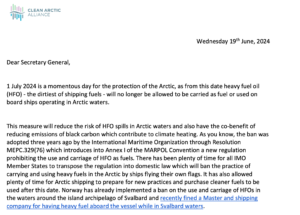
Letter to IMO Secretary General: The July 1st Heavy Fuel Oil Ban
1 July 2024 is a momentous day for the protection of the Arctic, as from this date heavy fuel oil (HFO) – the dirtiest of shipping fuels – will no longer be allowed to be carried as fuel or used on board ships operating in Arctic waters.

NGOs call on Arctic States to Drop Climate-Warming Loopholes Ahead of Arctic Heavy Fuel Oil Ban
Ahead of the July 1st coming into force of an International Maritime Organization (IMO) ban on the use and carriage heavy fuel oil (HFO) by Arctic shipping, the Clean Arctic Alliance today called on IMO member states, particularly Arctic coastal countries, to implement the Arctic HFO ban and enforce it fully with immediate effect – without resorting to loopholes.

Make a NO HFO Paper Boat!
Help us build a fleet of HFO-free ships, post your photos on social media and demand that the Arctic HFO ban to be implemented fully and now – not in five years’ time – to combat the Arctic meltdown and dire global consequences.

Webinar: The Arctic HFO Ban: Are you Ready for 1 July 2024?
This webinar will address the coming Arctic HFO ban, and why this regulation should be implemented by States and the shipping sector without the use of exemptions or waivers. This webinar will also look at the required next steps with respect to protecting the Arctic from the risks associated with using HFOs.
Heavy Fuel Oil Q&A
An FAQ on the coming ban on use and carriage of heavy fuel oil in the Arctic
HFO Infographics

Infographic: Are You HFO Ready?
The IMO’s Arctic heavy fuel oil (HFO) Regulation bans the use and carriage of HFO as fuel from 1 July 2024.
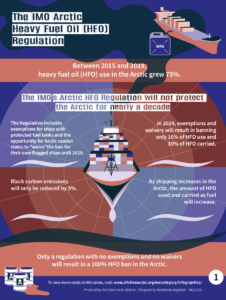
Infographic: The IMO Arctic Heavy Fuel Oil (HFO) Regulation
The IMO’s Arctic HFO Regulation will not protect the Arctic for nearly a decade.
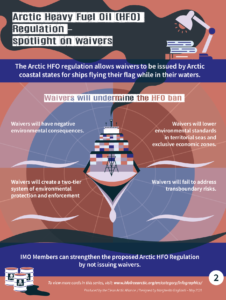
Infographic: Arctic Heavy Fuel Oil (HFO) Regulation: Spotlight on Waivers
Waivers will undermine the International Maritime Organization’s Arctic heavy fuel oil ban.
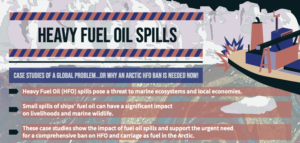
Infographic: Heavy Fuel Oil Spills – Case Studies of a Global Problem
Infographic: Heavy Fuel Oil Spills – Case Studies of a Global Problem
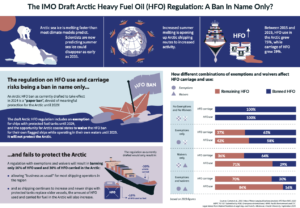
Infographic: The IMO Draft Arctic Heavy Fuel Oil (HFO) Regulation: A Ban In Name Only?
The IMO’s draft ban on heavy fuel in the Arctic risks being a “paper ban” devoid of meaningful protection of the Arctic.
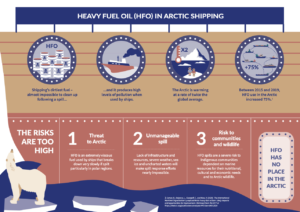
Infographic: Heavy Fuel Oil in Arctic Shipping
Heavy fuel oil (HFO) is shipping’s dirtiest fuel – almost impossible to clean up following a spill, and produces high levels of pollution when used by ships. The Arctic is warming at twice the global average. Between 2015 and 2019, HFO use in the Arctic increased 75%. This infographic demonstrates how HFO has no place in the Arctic.

